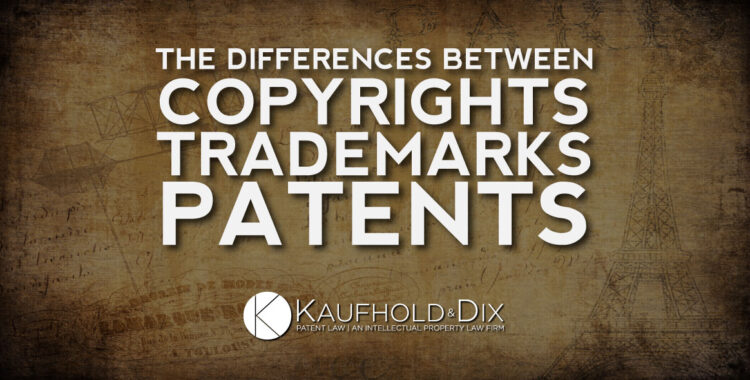The Difference Between Copyrights, Trademarks, and Patents
Copyrights, patents, and trademarks are the three main areas of intellectual property law and their differences mean that each offers you different avenues for protecting your rights. Inventors, business owners, and artists are all creative people and if you fall into any of these groups it is to your advantage to understand the differences between these protections. This post focuses on the differences between patents, trademarks, and copyrights and how they might be helpful for protecting your intellectual property.
Copyrights
A copyright is a set of rights that are put in place when an original work of art is produced. Examples of an original work can include, for example, photos, books, films, paintings, artistic designs, architectural drawings, and songs. As a copyright owner, you get to determine what happens with your work and specifically who can reproduce it. These rights also extend to controlling the creation of works that derive from your original work including variations in mediums such as transferring a novel into a screenplay and then into a movie. These are rights that you can assign or sell to others.
Copyright protection occurs automatically at creation. That is, once you create the original work, the copyright immediately attaches to it and you are not required to register your work with the US Copyright office. However, there are distinct advantages to registering your copyright. Primary among these is you can obtain statutory damages per each infringing act whether or not you were harmed, or the other side gained, from the infringement. That is, as long as the infringement occurred you can collect damages and copyright damages can be very substantial. If you have not registered your copyright, you will have to prove actual damages and aside from the difficulty in showing you were harmed, the losses you can show will typically be less that what would have been awarded for statutory damages.
Other advantages of registering your copyright include providing you with a right that has an extremely long life. Rights of a registered copyright extend 70 years beyond the author’s death and thus become rights that can extend onward for generations. Finally, the registering of a copyright is relatively easy and affordable and therefore should not be overlooked. You often cannot regain statutory damages by registering after an infringement has occurred and therefore it is important that you immediately file for protection after the original work has been created.
Trademarks
A trademark is typically a word, short phrase or design used to distinguish the source of the goods or services utilizing the trademark. The word “trademark” is commonly used interchangeably with the term “service mark.” Unlike a patent or copyright where your rights are safe regardless of usage, a trademark is only good as long as it is being used in commerce for the purpose of defining the source of goods or services. Thus, a trademark does not expire as long as you continue to use it and, on the federal level, continue to make maintenance filings.
A trademark often applies to a specific product or may apply to the company that is providing the product or service. Moreover, the same trademark can be used for different goods and services as trademarks are divided across multiple classes. Thus a sporting goods company may use the same trademarked name for tee-shirts, golf clubs, and as an operator of a retail store. When registering a trademark at the federal level, each class is considered a separate filing and it is therefore important to understand which goods and services are most in need of protection.
There are three levels of trademarks and they include common law trademarks, state trademarks, and federal trademarks. State trademarks are applied for in each state and are only enforceable in the state in which they are registered. State trademarks may be weakened by the fact that many states do not adequately prevent confusingly similar marks from being registered at the same time and therefore most people do not file for a state trademark to opt instead for a federal trademark which covers the entire United States and is examined thoroughly to prevent the mistake of awarding a registration for an undeserving mark.
A common law trademark is a trademark that is acquired by usage alone and therefore does not require an active registration process. If you opened a gas station on a street corner, common law trademark protection would prevent someone from opening a gas station across the street from you with a confusingly similar (or identical) name. Common law trademark only covers a geographic area in which your mark is relevant. Therefore it could cover the entire United States if it is an extremely popular item, though more likely it will only cover your current city or neighborhood. Thus, it is clear why federal trademark protection is more typically sought – it covers the entire United States without having to worry about what others are doing a few towns over.
The designation for a trademark registered with USPTO is the ® symbol. If the trademark has not been registered with USPTO, a T.M. or S.M symbol will accompany the mark. Filing for trademark protection typically includes many stages and it is typically unwise for a non-attorney to file a trademark application. The process usually begins with a search for similar marks to ensure that the mark is, in fact, available for registration. Should the findings be favorable, the attorney will file either an intent to use application where the mark is not actively being used in commerce or an actual use application where the mark is currently in use. If allowed, the intent to use filing will require a supplemental filing to prove that mark is actually being used.
Once filed, the trademark application is examined by a Trademark Examiner. The Examiner may issue an office action indicating the application is either deficient in some manner, the mark will not be allowed because it is too similar to another registration, or is rejected for being too descriptive or generic. A rejection for being too descriptive is difficult to overcome, which is why it is in your best interest to be creative when choosing a name for your product or business.
Should the mark be allowed by the Examiner, it is then published to allow third parties 30 days to oppose the mark if they feel that your mark should not be registered. If the 30 day window closes without an opposition, your mark will then be registered and will require maintenance at 5 years, 10 years and every 10 years thereafter.
Patents
A patent is a legal monopoly for a useful article granted by the United States Patent and Trademark Office. It excludes others from making, using, offering for sale, or selling an invention throughout the United States or importing the invention into the United States for a limited time in exchange for public disclosure of the invention.
Patents are categorized into design patents and utility patents. Generally, a design patent protects what the invention looks like. Design patents can prevent direct knock offs of inventions as well as protect a portion of an invention. Utility patents protect processes/methods, apparatuses/machines, and software/applications. Where a design patent protects the overall appearance of an invention, a utility patent protects its structure, function and variations thereof. Because of this, a utility patent generally provides broader protection than a design patent, but design patents can be used effectively in some industries to protect important improvements. Plant patents are also available should you create a new plant subspecies, though this is a very specialized area of law.
A utility patent is typically valid for 20 years from the date of filing. A design patent is valid for 15 years from the date of issuance. Both utility patents and design patents are important property rights that can be sold or licensed and many people will sell their invention or license it to others.
Securing patent protection can be long, complicated, and typically includes a more substantial financial investment than that of a trademark or copyright. For this reason, scheduling a free consultation with a patent attorney is recommended. The attorney will help you decide which type of patent is best suited to your invention and will have the highest chance of success at the USPTO. If your intellectual property attorney decides if your idea is patentable, the attorney will walk you through all the different steps of securing patent protection.
Learn More – Download The Intellectual Property Playbook
Whatever industry you are proficient at, whichever way you choose to go, it is vital to understand your legal rights. Understanding the difference between the copyrights, trademarks, and patents helps you select the right protection for your intellectual property. Download our free guide, The Intellectual Property Playbook – An Entrepreneur’s Guide To Patents, Trademarks, and Copyrights to learn more.
Intellectual Property Playbook
An Entrepreneur's Guide To Patents, Trademarks, and Copyrights GET THE PLAYBOOK






